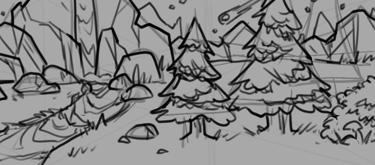

Chapter 3.1 Wildlife Resources
Resource Clusters
Resource Clusters are tied to their ecological deity, placed by them from eco shards. Eco shards are largely unseen, and are typically hidden and buried. These form resource clusters which are plants (trees, shrubs, etc) or minerals (ore, crystals, etc.) When left alone, resources grow and regrow to full strength when harvested (even if their deity is inactive.) Leaving a stump/base allows the resource to reform faster. In the world of Spirit Relics, all living plants and minerals function like living veins that grow and shrink, based on the world around them. Eco shards ensure resources will always return somewhere nearby.
Ways to Gather Resources
Harvest resources using tools like scythes, axes, and pickaxes
Loot from monster or animal bodies and guts that they have eaten or placed on their bodies
Gather from the ground as debris
Open and pick from a resource Inventory (fruit off of a tree, berries on a shrub, crops on a crop stem)
Cultivate by planting eco seeds, eco shards, or physically moving and replanting stumps/bases
Resource Behaviors
A single resource cluster is a group of plants in close enough proximity to each other. Clusters can be big or small. Edges of the cluster will expand overtime based on the ecology deity's base favor. Other factors can speed or slow resource spread. Cluster rot spreads in veining paths by default to cause natural empty paths, for players, vehicles, creatures, monsters, and NPC to traverse, in cases of overgrowth. Fully rotted resources can be destroyed by vehicles, and large creatures and monsters just by touching it. (Note that resources will never grow into a "boxed in" shape, even if influenced by players, in these instances, the resource will shatter and leave no resources and hurting the character who tried.)
Resource Spread Influencing Factors
Faster
The tile the resource is on, matches their natural ecology
Ecology dominance allows matching resources to overtake others
Animal(s)/Creature(s) visited the cluster and adds spread value
A skill is in affect (wildlife claim)
World events that favor spread
Increased based on deity favor
Slower
The tile the resource is on, doesn't match their natural ecology
Animal(s)/Creature(s) visited the cluster and adds negates spread value
A trait is in affect (monster claim)
World event doesn't favor spread
Decreased based on deity disfavor
No natural spread will occur if:
Rot or Radial Dominance is in the way
Some monsters can give a their own ecosystem cluster a radial dominance (this changes the tile space they are on to a different ecosystem)
Radial dominance will allow overtaking in the dominating radius
Construction or other asset is in the way
Land claim is too close
Cluster is at maximum size for evolution level
During a deity's replenishment cycle, blocked growth will be determined first. The calculated final total determines how much spread is in affect, and if there isn't room, a deity will summon resource meteor(s) to crash land somewhere else, to create more cluster growth.
Meteor Landing Zone Visuals
It looks like a giant magic circle, known as an Impact Marker. The inner circle gets bigger, the closer the meteor gets. Once the inner circle meets the outer circle, impact will occur. These meteors vary in size, and will not occur on active land claims. If a deity cannot perform a meteor landing when the need is present, a quest marker will appear for aligned wildlife claim players through their animal companion, and faith claim players through their altars. Players cannot build on impact markers.
When in an Closely Impending Impact
If a player is on the impact marker, they will experience a persistent, increasing earthquake. The screen will slowly turn more red. Your character can be severely injured or killed from a meteor impact. (Players can still resurrect if a resurrection point was made.) If a player logs off and turns into a firefly when a resource appears on them, they will be moved to the closest radius.
Other Resource Abilities
Evolve
After being left alone long enough, a resource will evolve
Leaving the stump will allow the resource to grow fully to its last evolved state
Each evolution phase gets slower
Players with wildlife claims can hasten the evolution speed of resources
Evolved resources will destroy resources that take up space too close to it
Create Creature Shard
Generates a creature shard to add more wildlife to the world
If there is enough wildlife shards have a chance to generate and not shatter
Lands with Resource Wipeouts
In the case where resources get decimated by creatures, NPC, world events, monsters, and/or players, if the deity has enough favor, it will continue to send meteors to replenish the land. Overtime, if unsuccessful, a deity can lose favor. In response the meteors will slowly seise, until the deity recovers the land, or favor reaches 0 for too long and goes inactive. Another ecological being, monsters or deities will move in to try to claim the location's ecology. Eventually, a desolation deity will take over by default, with the ecology being desolation. Large expanses of desolation can cause deeply unsafe areas. (More about deep areas later.)
As plant life evolves, so will the creatures.
